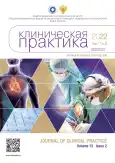The problems of the operated spine. Treatment of transpedicular fixation failure and the adjacent level pathology: A clinical case
- Authors: Ochkal S.V.1, Sorokovikov V.A.1,2, Seliverstov P.V.2, Larionov S.N.2, Potapov V.E.2, Zhivotenko A.P.2
-
Affiliations:
- Irkutsk State Academy of Postgraduate Education, Russian Medical Academy of Continuous Professional Education
- Irkutsk Scientific Center of Surgery and Traumatology
- Issue: Vol 13, No 2 (2022)
- Pages: 108-113
- Section: Case reports
- URL: https://journals.rcsi.science/clinpractice/article/view/89414
- DOI: https://doi.org/10.17816/clinpract89414
- ID: 89414
Cite item
Full Text
Abstract
Background: Among the modern methods of surgical treatment of the lumbar spine’s degenerative stenoses, decompressive-stabilizing surgical interventions using transpedicular screw-rod structures occupy an important place. The use of metal structures is justified not so much by the degenerative process specifics, degree or length of stenosis, but by the presence of instability in the spinal motion segments. In turn, the widespread use of fixing structures has naturally led to an increase in the specific complications, reaching 10–20 per cent of the total number of operated patients. One of the threatening complications of decompressive-stabilizing operations is the fracture of structural elements, often with the formation of pathology at the adjacent levels. The reasons for these complications are associated with both an erroneous choice of the construct parameters and a violation of the technique for installing the transpedicular fixation system (TPS). Clinical case description: The article presents an analysis of the clinical symptoms appearing with the formation of the adjacent level syndrome due to a fracture of the TPS system screws used to treat central stenosis of the spinal canal at the LIV -LV level. The correction of the pathology was carried out with a repeated surgical intervention. Conclusion: This clinical example draws attention to the combination of the adjacent level syndrome with a fracture of the metal structure in a patient after a decompressive-stabilizing operation using screw-rod fixation. An early diagnosis and adequate correction of the pathology helps to avoid the aggravation of symptoms and disability of patients.
Full Text
##article.viewOnOriginalSite##About the authors
Sergey V. Ochkal
Irkutsk State Academy of Postgraduate Education, Russian Medical Academy of Continuous Professional Education
Author for correspondence.
Email: ostin.vl@mail.ru
ORCID iD: 0000-0002-9969-8845
Graduate Student
Russian Federation, IrkutskVladimir A. Sorokovikov
Irkutsk State Academy of Postgraduate Education, Russian Medical Academy of Continuous Professional Education; Irkutsk Scientific Center of Surgery and Traumatology
Email: svladimir10@gmail.com
ORCID iD: 0000-0002-9008-6383
MD, PhD, Professor
Russian Federation, Irkutsk; IrkutskPavel V. Seliverstov
Irkutsk Scientific Center of Surgery and Traumatology
Email: pavv2001@gmail.com
ORCID iD: 0000-0002-4050-9157
MD, PhD, Professor
Russian Federation, IrkutskSergey N. Larionov
Irkutsk Scientific Center of Surgery and Traumatology
Email: snlar@mail.ru
ORCID iD: 0000-0001-9189-3323
MD, PhD, Professor
Russian Federation, IrkutskVitaly E. Potapov
Irkutsk Scientific Center of Surgery and Traumatology
Email: pva454@yandex.ru
ORCID iD: 0000-0001-9167-637X
MD, PhD
Russian Federation, IrkutskAlexander P. Zhivotenko
Irkutsk Scientific Center of Surgery and Traumatology
Email: sivotenko1976@mail.ru
ORCID iD: 0000-0002-4032-8575
MD, Junior Research Associate
Russian Federation, IrkutskReferences
- Walker BF. The prevalence of low back pain: a systematic review of the literature from 1966 to 1998. J Spinal Disord. 2000;13(3):205–217. doi: 10.1097/00002517-200006000-00003
- Casiano VE, Dydyk AM, Varacallo M. Back Pain. In: StatPearls. Treasure Island (FL): StatPearls Publishing; 2020.
- Melancia JL, Francisco AF, Antunes JL. Spinal stenosis. Handb Clin Neurol. 2014;119:541–549. doi: 10.1016/B978-0-7020-4086-3.00035-7
- Масевнин С.В., Пташников Д.А., Михайлов Д.А., и др. Роль основных факторов риска в раннем развитии синдрома смежного уровня у пациентов после спондилодеза поясничного отдела позвоночника // Хирургия позвоночника. 2016. Т. 13, № 3. С. 60–67. [Masevnin SV, Ptashnikov DA, Mikhailov DA, et al. The role of the main risk factors in the early development of adjacent-level syndrome in patients after lumbar spine fusion. Spine Surgery. 2016;13(3):60–67. (In Russ).] doi: 10.14531/ss2016.3.60-67
- Sutovsky J, Sutovska M, Kocmalova M, et al. Degenerative lumbar spondylolisthesis: biochemical aspects and evaluation of stabilization surgery extent in terms of adjacent segment disease theory. World Neurosurg. 2019;121:e554–e565. doi: 10.1016/j.wneu.2018.09.163
- Louie PK, Harada GK, Sayari AJ, et al. Etiology-based classification of adjacent segment disease following lumbar spine fusion. HSS J. 2020;16(2):130–136. doi: 10.1007/s11420-019-09723-w
- Ghiselli G, Wang JC, Bhatia NN, et al. Adjacent segment degeneration in the lumbar spine. J Bone Joint Surg Am. 2004;86(7): 1497–1503. doi: 10.2106/00004623-200407000-00020
- Knight RQ, Schwaegler P, Hanscom D, Roh J. Direct lateral lumbar interbody fusion for degenerative conditions: early complication profile. J Spinal Disord Tech. 2009;22(1):34–37. doi: 10.1097/BSD.0b013e3181679b8a
- Hijji FY, Narain AS, Bohl DD, et al. Lateral lumbar interbody fusion: a systematic review of complication rates. Spine J. 2017; 17(10):1412–1419. doi: 10.1016/j.spinee.2017.04.022
- Youssef JA, McAfee PC, Patty CA, et al. Minimally invasive surgery: lateral approach interbody fusion: results and review. Spine (Phila Pa 1976). 2010;35(26 Suppl):S302–311. doi: 10.1097/BRS.0b013e3182023438
Supplementary files










